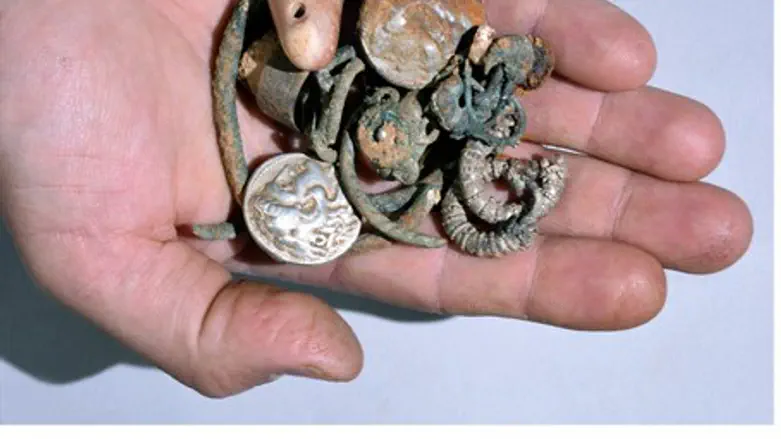
A month after the discovery of a massive hoard of gold treasure by divers off the coast of Caesarea, the Israel Antiquities Authority (IAA) has received reports of a find involving a cache of rare coins and silver and bronze objects 2,300 years old, in a cave in northern Israel.
According to IAA officials, this may be one of the most important archaeological discoveries in northern Israel in recent years, and requires in-depth research to decipher the secrets of the cave.
The story of the find begins two weeks ago, when Israeli Caving Club members Reuven Zakai, his son Chen, and their friend Lior Halony, journeyed into one of the largest and best-hidden stalactite caves in the north in preparation for a visit by the club.
The three spelunkered down into the cave, crawling through a narrow passage to enter it where they explored for several hours.
Chen, 21-years-old, says he forced his way into a narrow niche when he caught sight of something shining in the dark. He discovered two ancient silver coins that, it turns out, date from the reign of Alexander the Great, who conquered Israel at the start of the Hellenistic period (late 4th century BCE).
Along with the coins were found silver jewelry including rings, bracelets and earrings, that apparently were hidden in the cave in a cloth pouch roughly 2,300 years ago.
"The valuables might have been hidden in the cave by local residents who fled there during the period of governmental unrest stemming from the death of Alexander, a time when the Wars of the Diadochi broke out in Israel between Alexander’s heirs following his death," IAA archaeologists reasoned. "Presumably the cache was hidden in the hope of better days, but today we know that whoever buried the treasure never returned to collect it."
After realizing they had stumbled across an important archaeological find, the spelunkers contacted IAA, and this weekend officials together with Israeli Caving Club members entered the cave.
The IAA inspectors found evidence of human habitation in the caves over extended periods, and say they found artifacts first dating to the Chalcolithic period (c. 6,000 years ago), the Early Bronze Age (c. 5,000 years ago), the Biblical period 3,000 years ago and the Hellenistic period approximately 2,300 years ago.
Aside from the coins and jewelry, numerous pottery vessels were found, and on some of them stalagmites had development, while others bonded to the limestone sediments and could not be separated.
The combination of a stalactite cave and archaeological artifacts is a rare find according to the IAA, allowing both accurate dating of the finds and the stalactite development at the same time.
Amir Ganor, director of the IAA's Unit for the Prevention of Antiquities Robbery, praised the three spelunkers, noting "they understood the importance of the archaeological discovery and exhibited exemplary civic behavior by immediately bringing these impressive archaeological finds to the attention of the IAA."
"After the gold treasure from Caesarea, this is the second time in the past month that citizens have reported significant archaeological finds and we welcome this important trend," Ganor added. "Thanks to these citizens’ awareness, researchers at the Israel Antiquities Authority will be able to expand the existing archaeological knowledge about the development of society and culture in the Land of Israel in antiquity."
IAA emphasized that by law, all antiquities belong to the state, and not reporting or removing antiquities from their location is an offense punishable by up to five years in prison. Officials also note the location of the cave is being kept secret both to protect the archaeological strata and stalactites, but also to protect visitors from the hazards of the cave with its hidden pitfalls.